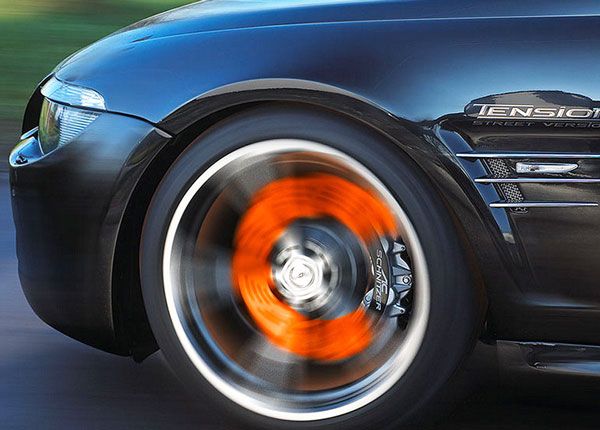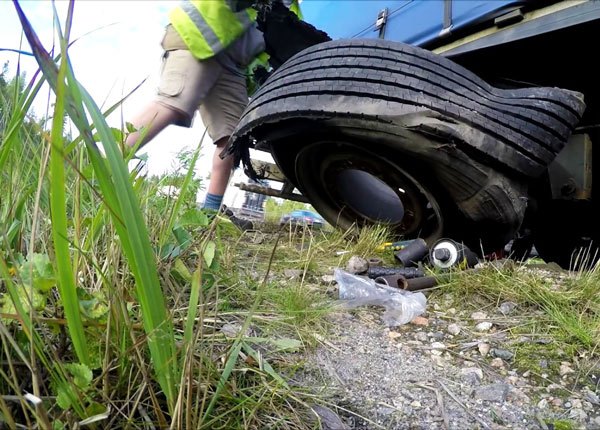
What To Do When Your Car Breaks Down: Mechanical Failures
Updated Dec. 29, 2020It is a simple fact that despite our best efforts, things sometimes go wrong. While there is a great deal that can be done to prevent your vehicle from sustaining mechanical and electrical failures, the risk can never be eradicated altogether. Automobiles are complex pieces of machinery. A fault in the smallest of components can lead to loss of steering, failed brakes or out-of-control acceleration.
Handling equipment failure
The first thing you must remember in any emergency is that panicking will only make things worse. Mechanical and electrical failures can be terrifying but in practically all cases, there is some action you can take to fix the problem. All you need to do is remain calm and recall the recovery guidance laid-out in this module. Learning how to handle driving emergencies is an essential part of your driver’s education program. The best defensive drivers are always ready when unexpected obstacles arise.
Every model of the car will respond differently in an emergency, based on its unique features and operating procedures. For this reason, your vehicle owner’s manual will always be the best source of information on handling mechanical failures. Read through it thoroughly and keep it in the glove compartment of your car.
Brake failure
Most modern vehicles are built with a split-brake system, which means it is very unlikely that braking power will be lost on all four wheels simultaneously. In a partial brake-failure, stopping power is usually lost on two or your four wheels. If this happens, you should be able to ease off the accelerator, brake gently and steer your vehicle off the side of the road. Seek roadside assistance and do not drive unless all brakes are fully operational.
Complete brake failure is a rarer and more frightening occurrence, which is more likely to happen in older vehicles without split-brakes. When experiencing a total brake failure, drivers should:
- 1

Pump the brake pedal to attempt to build pressure.
Skip this step if your vehicle has anti-lock braking (ABS). - 2

Drop into a lower gear if the brakes are still unresponsive.
- 3

Engage your parking brake slowly.
Do not allow wheels to lock. - 4

Drop into the lowest gear if the parking brake failed to stop the vehicle entirely.
This is the last resort, as it is likely to damage your engine.
It is important that you use your parking brake regularly to keep it functional for such emergencies. Servicing your primary brakes as the manufacturer recommends should keep them in good condition. Though, you must get them checked out at the first sign of unusual noises, leaking fluid or increased resistance. This is particularly important if you are often guilty of braking too hard or too frequently when driving on a steep decline.
Headlight failure
When headlights cut out, your first response must be to reduce your speed. Driving without lights at night, through the fog, during a rainstorm or in another low-visibility situation will limit your view of the road ahead, negatively impact your reaction time and prevent other road users from seeing you. Do not panic, use the taillights of the vehicle in front for guidance and follow these steps:
- 1

Attempt to revive the headlights by activating the dimmer switch, hitting the headlight switch on and off a few times or flashing your headlights.
- 2

When the above steps do not work, activate your hazard lights, parking lights and turn signals (if they are functional).
Pull your vehicle over to the side of the road, leaving only your hazard lights on while you wait for assistance.
It may be that your headlights are working but are noticeably less effective. This could be caused by a build-up or condensation on, or behind, the lenses. A cloudy yellow headlight can develop as the vehicle ages and is exposed to the sun. The former set of problems can usually be fixed with thorough service, whereas the latter may demand an entirely new set of headlights.
Tire blowout
Flat tires, tread separation and blowouts are usually the result of neglected or worn-out tires. Keeping your tires healthy depends on maintaining the correct tire pressure, keeping within vehicle and tire weight-bearing limits, avoiding hazards and conducting regular damage checks. Keep in mind that extremely hot weather will increase your chances of experiencing a tire failure.
If you experience a tire blowout, you will be tempted to brake hard or turn off the road immediately. In fact, doing as little as possible following a tire blowout is often the best way to maintain control and avoid a crash. You should hold the steering wheel with both hands and steer straight ahead. Gradually ease off the accelerator but do not put your foot on the brakes. The brakes should only be applied when the vehicle has almost completely stopped. As your vehicle slows, steer it gently off the side of the road to a safe spot.
Steering failure
Fortunately, complete steering failure on a moving vehicle is extremely rare. Total loss of steering could only be caused by a serious break in connection between the steering wheel and chassis. Partial steering failure resulting in the car pulling to one side, or power-steering failure resulting in much “heavier” steering, are far more likely occurrences. A power steering failure may also come with the bonus problem of failed power braking if it is the result of engine failure.
When steering fails, you must not panic or slam on the brakes. Instead, begin to slow the vehicle down by easing your foot off the accelerator. Then, activate your hazard lights to warn other road users that you are having mechanical problems. If you still have some steering control (as with partial or power steering loss) you can try to steer your vehicle gently off the side of the road, once your speed has dropped to around 30mph. You will have no choice other than to stop your vehicle on the road if your steering has failed totally. If this happens, be sure to reduce your speed gradually to allow drivers behind you the time to react.
Dead battery
If your car engine will not crank, or will crank but does not start, it is likely your battery is dead. A car’s battery is built to provide a brief blast of power to get the engine going. This single action will deplete the charge it carries significantly. Once your car is running, the engine will power the electrical systems and recharge the battery ready for the next time you need it.
Your battery may not be charged properly or may sustain damage if you only ever take your car out on short journeys. Failing to switch off an electrical feature such as the headlights when you switch the car off will rapidly run down the battery, as it is not designed to support such systems. When your car battery runs flat, jump-starting using another running vehicle may be your only option. Though keep in mind that this is not suitable for all vehicles – always check out your owner’s manual for guidance!
Headlights appearing dimmer, slower engine cranking, backfiring and a clicking sound when the ignition turns are all signs of a potential battery problem. Take your car to a mechanic if any of these issues arise. Also, keep your battery clean and free from corrosion during very hot and cold weather, as extreme temperatures will leave it more susceptible to wear.
Engine failure
Insufficient fuel, clutch malfunctions, airflow problems, overheating, a dead battery and a wide variety of other issues can make your engine die; this is called “stalling”. Engine stalling can be dangerous if it happens while the vehicle is in motion. If this happens, you must handle the situation by:
- Moving your vehicle to the roadside, if possible. If the vehicle is stuck on the roadway, all occupants must get out and move to a safe spot.
- If you manage to get your vehicle to the roadside, occupants may stay in the car unless there is a safer and more comfortable place to wait for assistance nearby. Lock your vehicle if you choose to leave it.
- Make sure your hazard lights are active or attach a brightly colored piece of cloth to the outside of the car to signal that you require assistance. Accept assistance from strangers with extreme caution.
- Walk in the same direction as the traffic if you must seek help. DO NOT walk on a freeway; remain with your vehicle.
Overheating and fires
Extreme heat can damage your engine and cause your vehicle to stall. In serious cases, heat may start a fire in your engine or elsewhere in the vehicle where combustible materials are present. If you smell or see smoke coming from your vehicle while driving, you must pull over and investigate. Small fires can often be put out with sand or a blanket – never use water on gasoline or electrical fires. If the fire is large or persists, move to a safe distance and contact the fire department.
Car engines can overheat on hot days, in stop-and-go traffic or when driving up a steep incline. In these situations, you must keep an eye on the engine temperature gauge and pull over if it moves into the red. Avoid running the air conditioning when your car’s engine is already under strain, as this would increase pressure on the engine and may lead it to overheat. If you must pull over to avoid overheating, be sure to let your engine cool before inspecting it or removing the radiator cap. While the car is still hot, the radiator may spray boiling liquid if the cap is removed.
Loss of visibility
Losing your windshield wiper function in rain, snow, fog or other adverse conditions could severely impair your view of the road ahead. If this happens, you must reduce your speed and increase your following distance smoothly but promptly. If several attempts to activate the wipers have been unsuccessful, you should pull your vehicle over at the next opportunity and investigate the problem. Wind down the window and lean your head slightly out to get a better view of the road when maneuvering your vehicle with reduced visibility.
Blown fuses, broken motors and loose pivot nuts are common causes of unresponsive wipers. When driving conditions demand the use of your wipers and you cannot get them working, it will be necessary to wait for roadside assistance and seek help from a mechanic.
Poorly secured hoods are another common cause of sudden visibility loss. The hood may pop open and totally obscure your view of the road if you do not fasten both latches securely. Always check this when you have had the hood open for engine maintenance.
Stuck accelerator
If your gas pedal malfunctions or gets stuck, your vehicle could accelerate to top speed in a few seconds. The best way to prepare for a stuck accelerator is to acquaint yourself with the guidance in your vehicle owner’s manual. As every vehicle has unique features and capabilities, knowing what is right for your car is essential.
Your state’s driving handbook will also be able to advise you on the best course of action when dealing with a jammed accelerator. You may be advised to shut the engine down or leave it running. Keep in mind that switching off the engine will result in loss of power steering and power braking – features you may need when bringing a speeding vehicle to a stop!
These steps are suitable for most vehicles and may help you stop safely if your accelerator gets stuck:
- Shift the car into neutral. This is essential. Without diminishing the power of the engine, you will not be able to apply the brakes hard enough to stop the car. Switch the engine off if you cannot shift to neutral but do not remove the key from the ignition.
- Push both feet firmly down on the brake pedal and leave them there.
- Search ahead for an escape route but do not change lanes or turn rapidly, as you may lose control of the vehicle.
A jammed accelerator may be caused by a mechanical or electrical malfunction, or by human error. Be sure to get your car serviced regularly and do not leave items on the floor of your car which could get stuck under the gas pedal.




